2012 Peugeot 508 RXH fuel filter
[x] Cancel search: fuel filterPage 37 of 304
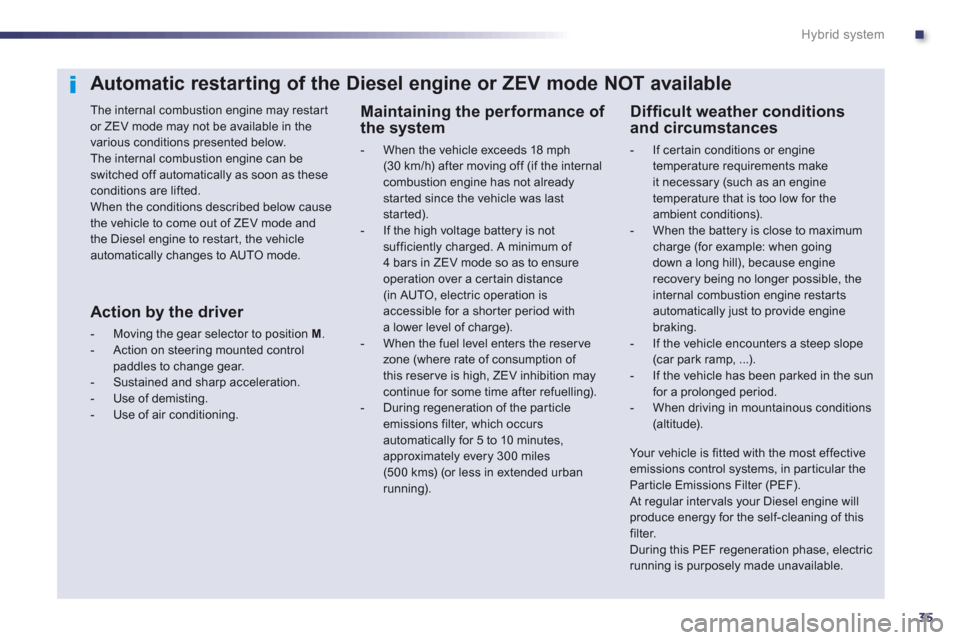
.
35
Hybrid system
Automatic restarting of the Diesel engine or ZEV mode NOT available
The internal combustion engine may restar t or ZEV mode may not be available in the various conditions presented below.
The internal combustion engine can be switched off automatically as soon as these conditions are lifted. When the conditions described below causethe vehicle to come out of ZEV mode and the Diesel engine to restar t, the vehicleautomatically changes to AUTO mode.
Diffi cult weather conditions and circumstances
- If certain conditions or engine
temperature requirements make it necessary (such as an enginetemperature that is too low for the ambient conditions). - When the battery is close to maximum charge (for example: when goingdown a long hill), because enginerecovery being no longer possible, theinternal combustion engine restarts automatically just to provide engine braking.- If the vehicle encounters a steep slope (car park ramp, ...).- If the vehicle has been parked in the sun for a prolonged period.- When driving in mountainous conditions (altitude).
Your vehicle is fitted with the most effectiveemissions control systems, in par ticular theParticle Emissions Filter (PEF). At regular intervals your Diesel engine will produce energy for the self-cleaning of this filter.During this PEF regeneration phase, electric running is purposely made unavailable.
Maintaining the performance of the system
- When the vehicle exceeds 18 mph
(30 km/h) after moving off (if the internal combustion engine has not alreadystarted since the vehicle was last started). - If the high voltage battery is notsufficiently charged. A minimum of 4 bars in ZEV mode so as to ensure operation over a cer tain distance (in AUTO, electric operation isaccessible for a shor ter period witha lower level of charge). - When the fuel level enters the reserve zone (where rate of consumption of this reserve is high, ZEV inhibition maycontinue for some time after refuelling).- During regeneration of the par ticle emissions filter, which occurs
automatically for 5 to 10 minutes, approximately every 300 miles(500 kms) (or less in extended urban running).
Action by the driver
- Moving the gear selector to position M.
- Action on steering mounted controlpaddles to change gear.
- Sustained and sharp acceleration.
- Use of demisting.
- Use of air conditioning.
Page 40 of 304
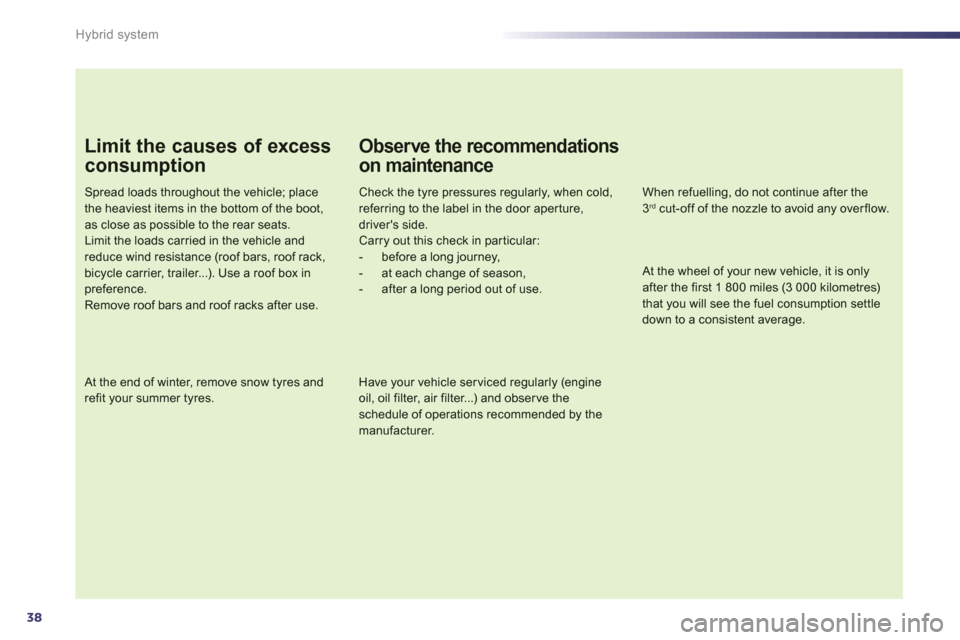
38
Hybrid system
Limit the causes of excess
consumption
Spread loads throughout the vehicle; placethe heaviest items in the bottom of the boot,as close as possible to the rear seats.Limit the loads carried in the vehicle andreduce wind resistance (roof bars, roof rack,bicycle carrier, trailer...). Use a roof box in preference.Remove roof bars and roof racks after use.
At the end of winter, remove snow tyres and refit your summer tyres.
Observe the recommendations
on maintenance
Check the tyre pressures regularly, when cold, referring to the label in the door aper ture, driver's side. Carry out this check in par ticular:
- before a long journey,
- at each change of season,
- after a long period out of use.
Have your vehicle ser viced regularly (engine oil, oil filter, air filter...) and obser ve the schedule of operations recommended by the
manufacturer.
When refuelling, do not continue after the3 rd
cut-off of the nozzle to avoid any overflow.
At the wheel of your new vehicle, it is onlyafter the first 1 800 miles (3 000 kilometres) that you will see the fuel consumption settle down to a consistent average.
Page 109 of 304
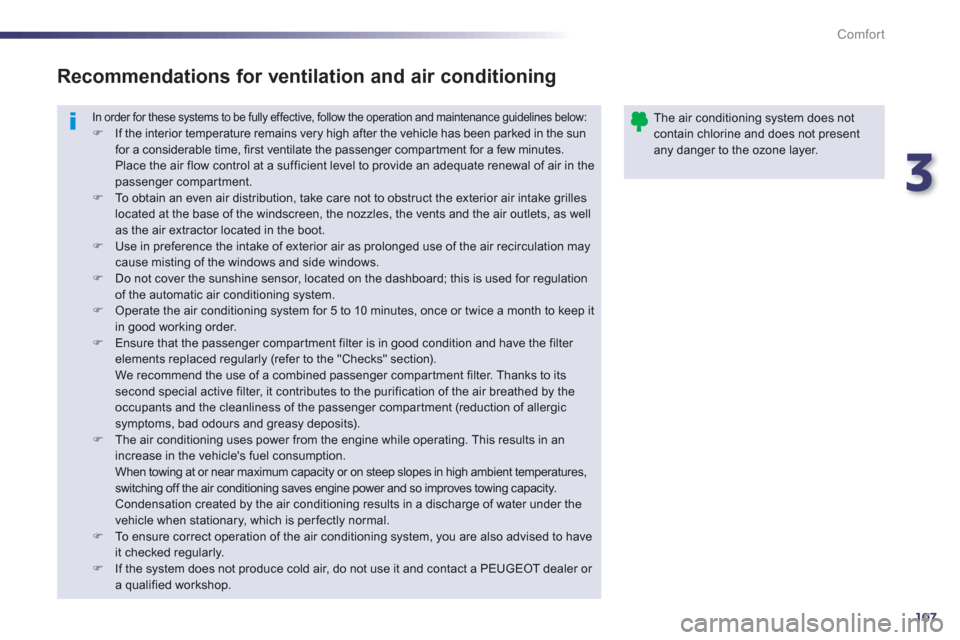
3
107
Comfort
In order for these systems to be fully effective, follow the operation and maintenance guidelines below: �)
If the interior temperature remains very high after the vehicle has been parked in the sunfor a considerable time, first ventilate the passenger compar tment for a few minutes. Place the air flow control at a sufficient level to provide an adequate renewal of air in the passenger compartment.�)
To obtain an even air distribution, take care not to obstruct the exterior air intake grilles located at the base of the windscreen, the nozzles, the vents and the air outlets, as wellas the air extractor located in the boot. �)
Use in preference the intake of exterior air as prolonged use of the air recirculation maycause misting of the windows and side windows.�)
Do not cover the sunshine sensor, located on the dashboard; this is used for regulation of the automatic air conditioning system.�)
Operate the air conditioning system for 5 to 10 minutes, once or twice a month to keep itin good working order. �)
Ensure that the passenger compar tment filter is in good condition and have the filter elements replaced regularly (refer to the "Checks" section). We recommend the use of a combined passenger compartment filter. Thanks to its second special active filter, it contributes to the purification of the air breathed by the occupants and the cleanliness of the passenger compartment (reduction of allergic symptoms, bad odours and greasy deposits).
�)
The air conditioning uses power from the engine while operating. This results in anincrease in the vehicle's fuel consumption. When towing at or near maximum capacity or on steep slopes in high ambient temperatures,switching off the air conditioning saves engine power and so improves towing capacity. Condensation created by the air conditioning results in a discharge of water under thevehicle when stationary, which is perfectly normal.�)
To ensure correct operation of the air conditioning system, you are also advised to haveit checked regularly.�)
If the system does not produce cold air, do not use it and contact a PEUGEOT dealer or a qualified workshop.
Recommendations for ventilation and air conditioning
The air conditioning system does notcontain chlorine and does not present any danger to the ozone layer.
Page 220 of 304
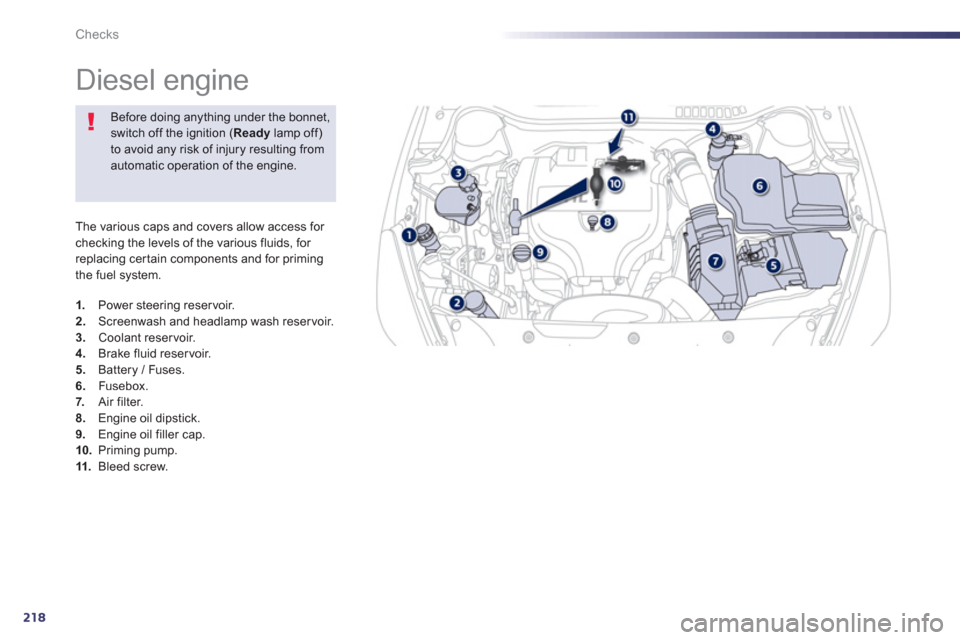
218
Checks
The various caps and covers allow access for checking the levels of the various fluids, for replacing cer tain components and for primingthe fuel system.
Diesel engine
1.
Power steering reservoir.2.
Screenwash and headlamp wash reservoir.3.
Coolant reser voir. 4.
Brake fluid reservoir.5.
Battery / Fuses.
6.Fusebox.7. Air filter.8.Engine oil dipstick. 9.
Engine oil filler cap.10.Priming pump. 11.
Bleed screw.
Before doing anything under the bonnet,switch off the ignition (Readylamp off) to avoid any risk of injury resulting from automatic operation of the engine.
Page 291 of 304

.
289 Alphabetical index
ABS ...............................................................170Accessories ............................................27,213Accessory position..........................................27Accessory socket, 12 volt...............................97Adaptive lighting..............................................47Adjusting headlamps....................................150Adjusting head restraints................................90Adjusting seat belt height ..............................174Adjusting the steering wheel ...........................96Airbags............................................................56Airbags, curtain.....................................178,179Airbags, front.........................................176,179Airbags, lateral......................................178,179Air conditioning...............................................37Air conditioning, digital...........107, 108,111, 116Air conditioning, manual...............................107Air conditioning, quad-zone ...........111, 114, 116Air filter..........................................................r222Air flow............................................................37Air vents ........................................................106Alarm ...............................................................76Anti-lock braking system (ABS)....................170Anti-theft..........................................................27Armrest............................................................97Armrest, rear...................................................r98ASR...............................................................170Assistance, emergency braking...................170Assistance call ......................................169, 232Audible warning ............................................ 169Audio streaming (Bluetooth).........................276Automatic illumination
of headlamps ......................................143, 147Automatic operation
of hazard warning lamps............................168Automatic rain sensitive
windscreen wipers ..............................152, 154
Capacity, fuel tank ..........................................85Central locking................................................70Changing a bulb............................191, 195, 197Changing a fuse............................................198Changing a wheel.........................................186Changing a wiper blade........................155,206Changing the date...........................................65Changing the remote control battery........73, 74Changing the time...........................................65Checking levels.....................................219-221Checking the engine oil level..........................61Checking tyre pressures (using the kit)........180Checks..........................................218,222-224Children.........................................162,165, 166Child seats ...........................................158,163Child seats, conventional ...................... 161,162Closing the boot ..............................................80Closing the doors ............................................70Connectors, audio ...........................................99Coolant level ...........................................57,220
A
C
Coolant temperature indicator........................r57Courtesy lamps .............................................156Cruise control........................................ 133, 136Cup holder.......................................................r97
Backup starting .............................................203Backup switching off.......................................f28Battery.............4, 22,40-42, 101, 202-204, 222Battery, charging..................................202,204Battery, remote control.............................73-75Bluetooth (hands-free)..................................259Bluetooth (telephone)....................................259Boot...........................................................80-82Boot (opening).................................................69Brake discs ............................................223,224Brake lamps ..................................................195Brake pads ............................................223,224Brakes...................................................223,224
B
Date (setting) ...................................................65Daytime running lamps.........145,191, 192, 194Deactivating ESP .......................................... 172Deactivating the passenger airbag...............176Deadlocking....................................................71Defrosting ................................................94, 116Diesel.................................................35,36,48Diesel additive level ...................................... 221Diesel engine pre-heat warning lamp.............48Dimensions...................................................228Dipped beam ............................ 47, 142, 191-193Dipstick....................................................61,219Directional lighting........................................ 151Direction indicators .......146, 168, 191,194,195Driving positions (memorising).......................89Dynamic emergency braking ........................119Dynamic stability control (DSC)......................................50,54,170,172
D
EBA (Emergency braking assistance) ..........170EBFD.............................................................170Eco-driving .....................................................37Economical driving.........................................37Economy mode.............................................205
E
Page 293 of 304
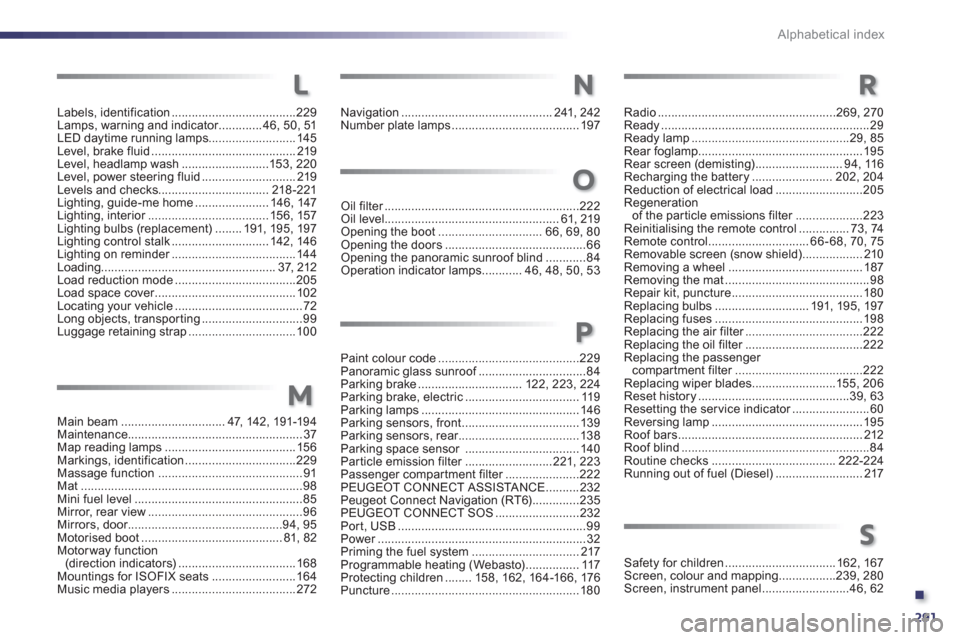
.
291 Alphabetical index
Labels, identification.....................................229Lamps, warning and indicator.............r46,50, 51LED daytime running lamps..........................145Level, brake fluid ...........................................219Level, headlamp wash..........................153,220Level, power steering fluid............................219Levels and checks.................................218-221Lighting, guide-me home......................146, 147Lighting, interior....................................r156,157Lighting bulbs (replacement)........191, 195, 197Lighting control stalk.............................142, 146Lighting on reminder.....................................r14 4
Loading....................................................37, 212Load reduction mode....................................205Load space cover..........................................r102Locating your vehicle......................................72Long objects, transpor ting..............................99Luggage retaining strap................................100
Main beam ............................... 47, 142, 191-194Maintenance....................................................37Map reading lamps ....................................... 156Markings, identification.................................229Massage function...........................................91Mat..................................................................98Mini fuel level..................................................85Mirror, rear view..............................................96Mirrors, door..............................................r94,95Motorised boot ..........................................81,82Motorway function(direction indicators) ................................... 168Mountings for ISOFIX seats.........................164Music media players.....................................272
Navigation.............................................241, 242Number plate lamps......................................197
Oil filter..........................................................r222Oil level....................................................61,219Opening the boot...............................66,69,80Opening the doors ..........................................66Opening the panoramic sunroof blind ............84Operation indicator lamps............46,48, 50,53
Radio.....................................................269, 270Ready..............................................................29Ready lamp...............................................29, 85Rear foglamp .................................................195Rear screen (demisting)..........................94, 116Recharging the battery ........................202, 204Reduction of electrical load ..........................205Regeneration of the par ticle emissions filter....................r223Reinitialising the remote control...............73, 74Remote control..............................66-68, 70, 75Removable screen (snow shield) ..................210Removing a wheel ........................................187Removing the mat...........................................98Repair kit, puncture.......................................180Replacing bulbs ............................ 191, 195, 197Replacing fuses............................................198Replacing the air filter...................................r222Replacing the oil filter...................................r222Replacing the passenger compartment filter......................................r222Replacing wiper blades .........................155,206Reset history.............................................39, 63Resetting the service indicator.......................r60Reversing lamp.............................................195Roof bars.......................................................212Roof blind........................................................84Routine checks.....................................222-224Running out of fuel (Diesel)..........................217
Safety for children .................................162, 167Screen, colour and mapping .................239, 280Screen, instrument panel ..........................46, 62
L
M
N
O
R
S
Paint colour code ..........................................229Panoramic glass sunroof................................f84Parking brake ............................... 122, 223,224Parking brake, electric .................................. 119Parking lamps...............................................146Parking sensors, front...................................139Parking sensors, rear....................................r138Parking space sensor ..................................140Particle emission filter..........................r221, 223Passenger compartment filter......................r222PEUGEOT CONNECT ASSISTANCE ..........232Peugeot Connect Navigation (RT6) ..............235PEUGEOT CONNECT SOS.........................232Port, USB........................................................99Power..............................................................r32Priming the fuel system................................217Programmable heating (Webasto)................117Protecting children ........158,162, 164-166,176Puncture ........................................................180
P
Page 299 of 304
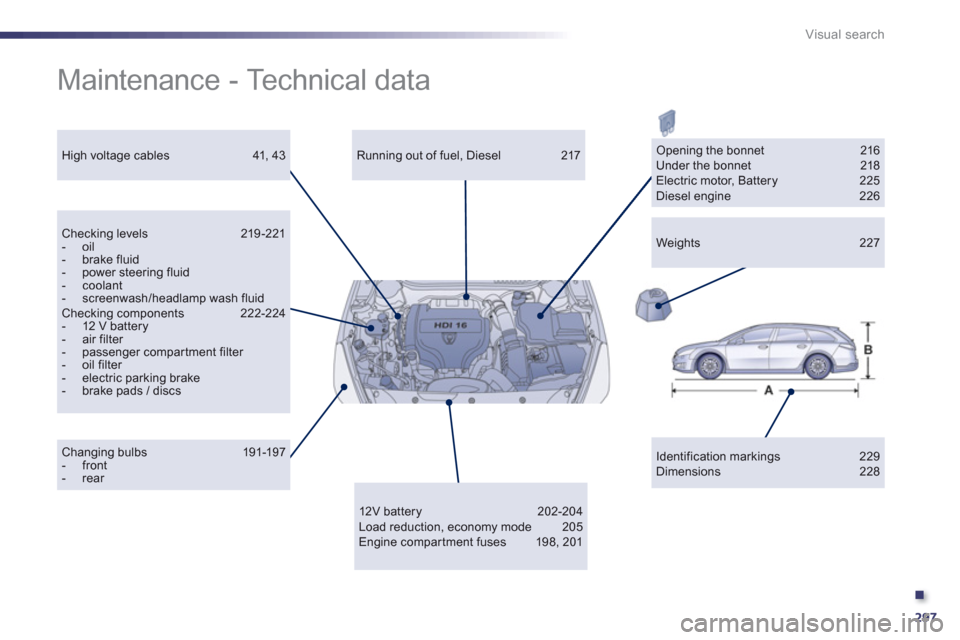
.
297
Visual search
Maintenance - Technical data
Identification markings 229 Dimensions 228
Running out of fuel, Diesel 217
Checking levels 219-221- oil - brake fluid - power steering fluid - coolant- screenwash/headlamp wash fluid Checking components 222-224- 12 V battery - air filter - passenger compartment filter - oil filter - electric parking brake- brake pads / discs
Changing bulbs 191-197- front- rear
Opening the bonnet 216 Under the bonnet 218 Electric motor, Battery 225 Diesel engine 226
12V bat tery 202-204
Load reduction, economy mode 205
Engine compar tment fuses 198, 201
Weights 227
High voltage cables 41, 43